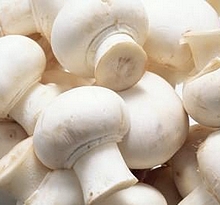

Mushrooms are the edible fleshy fruiting bodies of certain fungi, which may be gathered wild or grown under cultivation. The most commonly cultivated mushroom species is Agaricus bisporus.
Cultivated mushrooms are usually grown in the dark in climate-controlled rooms. The fungal innoculum or 'spawn' is added to a pasteurised substrate in growing containers or beds. After the fungal strands (mycelia) have spread through the compost, a layer of peat or soil (the 'casing') is added. The fruiting bodies begin appearing about 6 weeks after spawning and continue appearing in flushes about 7-10 days apart for the next 6-8 weeks. The first three flushes are the most productive. The cap and a small section of connected stem are usually harvested before the caps are fully expanded.
Mushrooms are grown in specially constructed sheds. (Existing farm buildings can be used, but require major modifications and even then still have some limitations.) There is no standard size or design of buildings for mushroom culture. Factors to include when planning include construction costs, machinery space requirements, tray or bed size, and stacking design. Doors must be designed to suit all machinery and equipment that is used. Windows are not required. Although mushrooms do not require complete darkness to grow, do not allow direct sunlight to reach the beds.
Copyright © 2017 All Rights Reserved